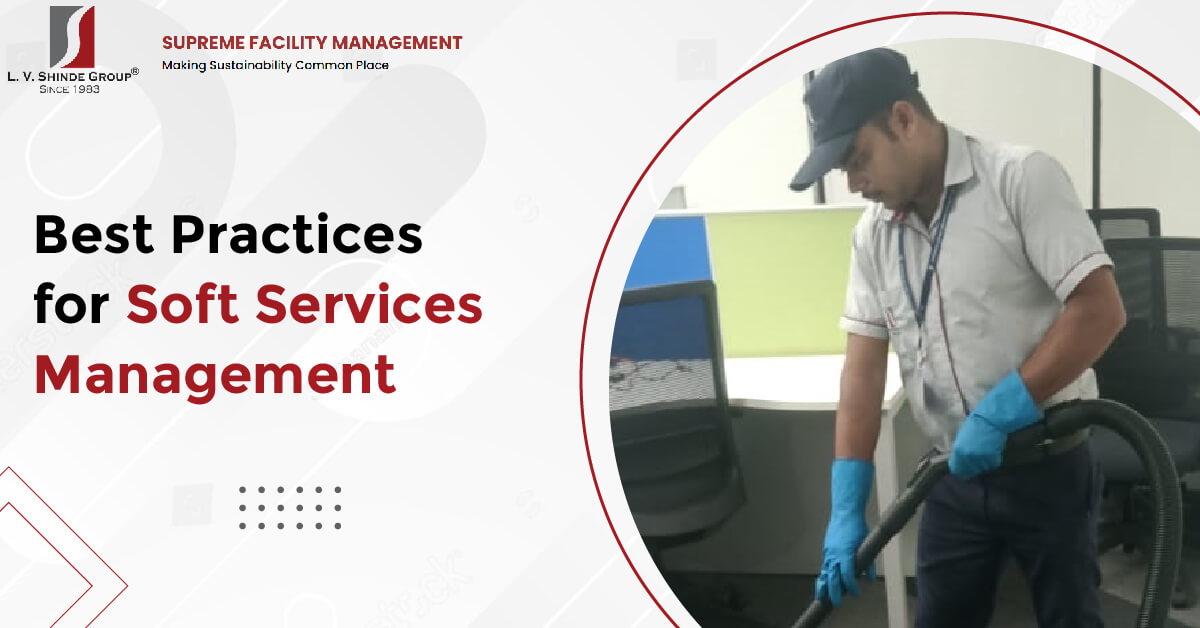Best Practices for Soft Services Management
In the realm of facility management, soft services play a pivotal role in creating a comfortable and efficient environment for occupants. Unlike hard services that deal with physical infrastructure, soft services are intangible yet indispensable aspects that contribute to the overall well-being of a facility. In this comprehensive guide, we’ll delve into the top 15 best practices for managing soft services effectively. We’ll also discuss future trends in soft services management and wrap up with a conclusion and a compelling call to action for facility managers.
Top 15 Best Practices for Soft Services Management
Effective management of soft services requires a strategic approach that focuses on delivering high-quality services, optimizing resources, ensuring compliance, and continuously improving processes. Here are 15 best practices for managing soft services in facilities:
1. Comprehensive Needs Assessment:
Conduct a thorough assessment of soft service requirements based on facility type, size, occupancy, and specific needs of occupants. Consider factors such as cleaning frequency, security risks, catering preferences, and sustainability goals.
2. Service Level Agreements (SLAs):
Define clear SLAs with service providers outlining service scope, quality standards, response times, performance metrics, and escalation procedures. SLAs should align with organizational objectives and occupant expectations.
3. Vendor Selection and Management:
Choose reputable and experienced vendors for soft services based on their expertise, track record, capabilities, and compliance with industry standards. Establish strong vendor relationships and regularly evaluate vendor performance.
4. Training and Development:
Provide comprehensive training to soft service staff on service protocols, safety procedures, customer service skills, use of equipment and technology, and compliance requirements. Invest in ongoing professional development to enhance staff capabilities.
5. Quality Assurance and Inspections:
Implement robust quality assurance programs including regular inspections, audits, feedback mechanisms, and performance reviews. Monitor service delivery, identify areas for improvement, and address issues promptly.
6. Technology Integration:
Leverage technology solutions such as facility management software, IoT devices, mobile apps, and digital platforms to streamline operations, automate tasks, track performance metrics, and enhance communication.
7. Sustainability Initiatives:
Integrate sustainability practices into soft service operations by adopting eco-friendly cleaning products, implementing waste reduction strategies, promoting energy efficiency, and supporting green initiatives.
8. Risk Management:
Identify potential risks and hazards related to soft services such as security threats, safety incidents, service disruptions, and regulatory non-compliance. Develop risk mitigation plans, emergency response protocols, and contingency measures.
9. Occupant Engagement:
Foster positive interactions with occupants through effective communication, feedback mechanisms, surveys, and occupant engagement initiatives. Understand occupant preferences, address concerns promptly, and prioritize occupant satisfaction.
10. Budgeting and Cost Management:
Develop accurate budget projections for soft services based on service requirements, vendor contracts, operational costs, maintenance expenses, and capital investments. Monitor expenses, identify cost-saving opportunities, and optimize resource allocation.
11. Continuous Improvement:
Implement a culture of continuous improvement by encouraging innovation, sharing best practices, conducting regular performance reviews, and implementing feedback-driven improvements. Foster a learning environment that promotes excellence and adaptability.
12. Compliance and Regulatory Requirements:
Stay updated with relevant regulations, industry standards, health and safety guidelines, environmental requirements, and labor laws affecting soft services. Ensure compliance through regular audits, training programs, and adherence to best practices.
13. Emergency Preparedness:
Develop and maintain emergency response plans, contingency strategies, evacuation procedures, and crisis communication protocols for soft services. Conduct drills, simulations, and training exercises to prepare staff for emergencies.
14. Data Analytics and Reporting:
Utilize data analytics tools to gather insights, track key performance indicators (KPIs), analyze trends, and generate actionable reports for informed decision-making, performance management, and strategic planning.
15. Collaboration and Communication:
Foster collaboration among internal teams, service providers, vendors, and stakeholders involved in soft services management. Establish effective communication channels, regular meetings, and feedback loops to ensure alignment and transparency.
By implementing these best practices, facility managers can optimize the delivery of soft services, enhance occupant satisfaction, mitigate risks, achieve cost efficiencies, and drive continuous improvement within their facilities.
Future Trends in Soft Services Management
The landscape of soft services management is constantly evolving, driven by technological advancements, changing occupant expectations, sustainability trends, regulatory developments, and industry innovations. To stay ahead of the curve, facility managers need to be aware of emerging trends and adapt their strategies accordingly. Here are some future trends in soft services management:
1. IoT and Smart Buildings:
Integration of IoT devices, sensors, and smart building technologies to automate tasks, monitor facilities in real-time, optimize resource utilization, and enhance occupant comfort and safety.
2. Data-driven Decision-making:
Increasing use of data analytics, predictive analytics, AI-driven insights, and machine learning algorithms to analyze facility data, identify patterns, predict maintenance needs, and optimize service delivery.
3. Remote Monitoring and Management:
Adoption of remote monitoring tools, mobile apps, cloud-based platforms, and virtual collaboration solutions to manage soft services, track performance, and respond to issues remotely.
4. Sustainability and Green Practices:
Emphasis on sustainable practices such as green cleaning, energy conservation, waste reduction, carbon footprint reduction, renewable energy adoption, and eco-friendly initiatives.
5. Enhanced Security Technologies:
Deployment of advanced security technologies including biometrics, facial recognition, AI-powered surveillance, access control systems, and cybersecurity measures to enhance facility security.
6. Augmented Reality (AR) and Virtual Reality (VR):
Use of AR and VR technologies for training, maintenance inspections, virtual tours, interactive guides, and immersive experiences to improve service quality and efficiency.
7. Customer Experience Focus:
Shift towards a customer-centric approach with personalized services, customized experiences, feedback-driven improvements, and technology-enabled convenience for occupants.
8. Agile and Flexible Service Delivery:
Adoption of agile methodologies, flexible service contracts, on-demand services, modular solutions, and adaptive strategies to meet evolving needs and dynamic environments.
9. Collaborative Ecosystems:
Development of collaborative ecosystems involving multiple service providers, vendors, partners, and stakeholders to deliver integrated solutions, shared resources, and synergistic benefits.
10. Ethical and Responsible Practices:
Emphasis on ethical business practices, social responsibility, diversity, equity, inclusion, fair labor practices, and community engagement in soft services management.
These future trends reflect the ongoing transformation and innovation within the facility management industry, highlighting the importance of embracing technology, sustainability, agility, customer focus, collaboration, and ethics in soft services management strategies.
Conclusion
Soft services are integral components of facility management that contribute significantly to occupant experience, well-being, and overall facility performance. Effective management of soft services requires a strategic approach, adherence to best practices, adoption of technology, continuous improvement, and alignment with industry trends.
By understanding the nature of soft services, differentiating them from hard services, implementing best practices, and embracing future trends, facility managers can optimize service delivery, enhance occupant satisfaction, achieve operational efficiencies, mitigate risks, and drive sustainable outcomes.
As the landscape of soft services management continues to evolve, staying informed, adaptable, and proactive is essential for success in delivering exceptional facility experiences. Embracing innovation, collaboration, data-driven insights, and customer-centricity will be key drivers of excellence in soft services management.
Elevate Your Soft Services with Supreme Facility Management Solutions!
Are you ready to elevate your soft services management strategy and create exceptional facility experiences? Contact us today to learn how Supreme Facility Management’s comprehensive solutions, experienced team, and innovative technologies can help you achieve your facility management goals. Let’s partner to optimize your soft services, enhance occupant satisfaction, and drive sustainable performance. Unlock your facility’s full potential with our tailored soft services management solutions. Contact us now to get started!


